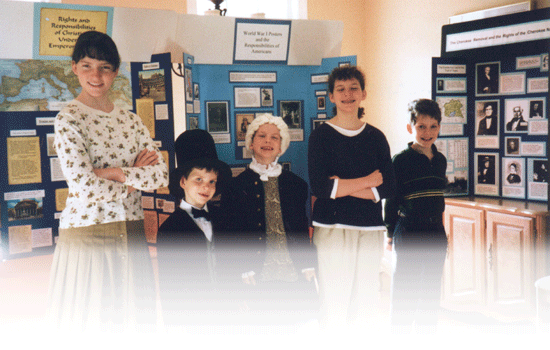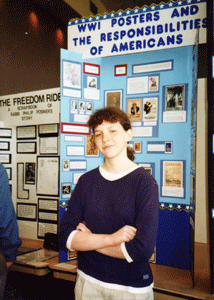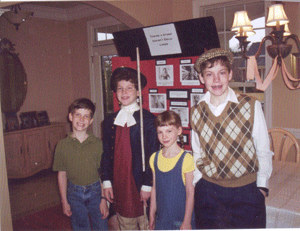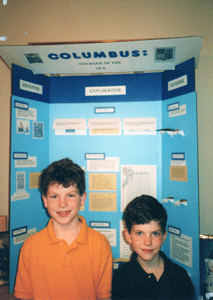
In our home, we try to connect our children to real life by giving them
meaningful projects. The National History Day program has been a great
way for them to see the purpose in a research project.
In The Horse and His Boy, C.S. Lewis contrasted story-telling to
essay-writing and commented that “The difference is that people want to
hear the stories, whereas I never heard of anyone who wanted to read the
essays.” National History Day, however, provides our students with an
interested audience for their essays and projects. This has motivated
them to learn to research and communicate important ideas.
The National History Day has categories for everyone. Our family got
involved when one of our daughters developed a passion for history.
Further siblings participated because they liked making displays or had
a taste for performing. There are papers, exhibits, performances and
documentaries, with divisions for both junior and senior high. All
categories, except papers, can be either individual or group efforts.
We would like to share with you how to get involved and how you can
maximize your National History Day participation.
How Can You Get Involved?
To find the nearest history day fair, visit the National History Day
site. Each state has
district competitions that feed contestants to the state competition.
Some students even have the opportunity to attend the national contest
held each June at the University of Maryland. Regardless of how far you
go, the value of National History Day can be realized at every level of
competition. In fact, our daughter who attended the national contest
still considers the local history fair her favorite.
Each year the National History Day is announced at
www.nationalhistoryday.org. The themes are usually general, such as
“Rights and Responsibilities,” and they lend themselves to a variety of
topics. In fact, our local History Day administrator confided that you
could research any topic-the challenge would be to correlate it to the
theme.
The Secret to History
Primary resources are the secret to unlocking history. Primary resources
include eyewitness accounts, letters, diaries, legal documents,
photographs, and artwork (such as World War I posters.) They are
“first-hand accounts,” while secondary resources, such as textbooks, are
“second-hand accounts.” For the National History Day project, students
are required to sort their resources into two lists: primary and
secondary resources. For many students, this simple exercise opens their
eyes to the significance of historical documents. They learn the value
of ad fontes, the Reformation concept of going “to the fount” or source
of information.
 Primary resources can be found in libraries, on the Internet, or in your
attic. If the topic concerns something that happened in the last sixty
years, you may even be able to find someone to interview about their
experiences related to the topic. This is a great way for a student to
spend time with a grandparent or great-grandparent. For example, my son
interviewed his grandfather about the changes in telecommunication that
he witnessed during his years working in the field.
Primary resources can be found in libraries, on the Internet, or in your
attic. If the topic concerns something that happened in the last sixty
years, you may even be able to find someone to interview about their
experiences related to the topic. This is a great way for a student to
spend time with a grandparent or great-grandparent. For example, my son
interviewed his grandfather about the changes in telecommunication that
he witnessed during his years working in the field.
Interviews may be verbal or written. One useful technique is to
interview by email so that you have the complete interview in written
form.
Strategy
To develop a research project with depth and analysis, students need to
carefully choose their topic. They should ask themselves:
- Can I find a way to relate this topic to the theme?
- Is this topic so broad that I cannot adequately research it?
- Is this topic so narrow that I will be unable to find resources for
researching it?
Students should read about their topics and make sure that they have
ideas for finding primary documents. When they are satisfied with a
topic, they should seek a variety of sources, including both secondary
and primary documents. The Internet provides a wealth of information.
Teach students to record bibliographic information for their resources
as they do the research, because it will be difficult to reconstruct
this data later. Also, teach them to look for references to primary
documents within the secondary documents that they are studying. Often
an encyclopedia or textbook will refer to a diary, letter, or document
which the student can find for himself.
Analysis and Interpretation
When we first began participating in history fairs, we took a “strict
constructionist” view of history. We thought that the simple truth
should speak for itself. We soon learned that no matter how many
interesting facts are presented, the project is not complete without
analysis and interpretation. For example:
- Why is this topic significant in history?
- What conclusions could you draw?
- How does this topic relate to the History Day theme?
- How was the topic influenced by the events of that time period?
A large part of a student’s score will be based on the quality of
analysis and interpretation demonstrated in the project. As the project
develops, it is useful to ask these analytical questions again and
again.

Following the Rules is Key
The National History Day site outlines the rules for each type of entry.
There are size requirements for exhibits and time limitations for
presentations. Every project must have an annotated bibliography that
uses a consistent format, such as MLA.
Following detailed rules may be a new idea to students, but it will have
a great impact not only on their scores, but on the rest of their lives.
If they can learn this concept now, they will not need lessons in how to
fill out job applications or how to prepare college papers.
The Process Paper
One of the most important qualifications for the History Day project is
the process paper. All categories, except the historical paper category,
require this short document of no more than 500 words. The process paper
explains how the student’s topic relates to the theme and describes how
the student conducted research and created the project. It also includes
the annotated bibliography. Examples of process papers and
bibliographies are available at the National History Day website.
For a paper that stands out above others, remember to start your paper
with an interesting “hook” or statement, and don’t forget to include the
challenges and solutions that you encountered.
The Interview
At the national level, and for many state and local competitions, an
interview accompanies the entry. If this is your first year, you may not
know which categories require an interview, so it is best to prepare for
this contingency. The work will not be wasted. Have one of the parents
pretend to be a judge and ask a variation of these questions:
- Tell me about your topic.
- Why do you think it is important?
- How does it relate to the theme?
- What was something interesting that you learned?
Time Management
The greatest challenge to participation in the National History Day is
time management. Most local fairs are in March and state fairs are in
April or May. Though the themes are announced earlier, students are
expected to present only work completed during the current school year.
Students should begin by late December.
 In our homeschool we schedule time into the school day for research and
writing. It is a good idea to take the number of weeks that you have,
and divide them into 30 percent research, 30 percent project
development, 30 percent further research and development (including
preparation of the process paper), and 10 percent rehearsing the
interview.
In our homeschool we schedule time into the school day for research and
writing. It is a good idea to take the number of weeks that you have,
and divide them into 30 percent research, 30 percent project
development, 30 percent further research and development (including
preparation of the process paper), and 10 percent rehearsing the
interview.
Research goes on throughout the project, but if you require students to
start creating their entry when they are 30 percent through the contest
period, they will realize that there is further research that needs to
be done, and they will still have time to do it. This schedule also
gives them time to analyze and interpret their data.
Meaningful Projects
For our family, the History Day project has become an integral part of
our curriculum. For this reason, it replaces a research paper from their
history or English program. In many ways the project brings schoolwork
into the realm of real life. They learn how primary resources should be
valued and consulted to understand history. They develop communication
and writing skills. In addition they have the opportunity to learn more
about the experiences of grandparents and family friends, who have
taught us that we are much closer to history than we realized.
Who will be the gatekeepers for the next generation of historians? Who
will tell the story of history? It is my hope that many from the ranks
of homeschoolers will be trained and ready when the time comes.
| There are many excellent sources of
primary documents online.
Here are a few to get you started:
|
Joyce McPherson is the creator of the online programs “Homeschool Tools”
and “Shakespeare Tools,” as well as the author of a series of
biographies for Greenleaf Press. With her husband, Garth, she
homeschools their nine children. She can be reached through
teachingtools.org or at mcpclan@comcast.net.